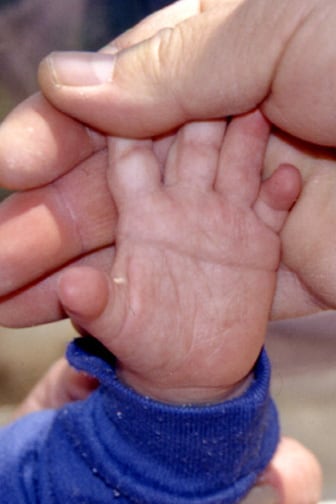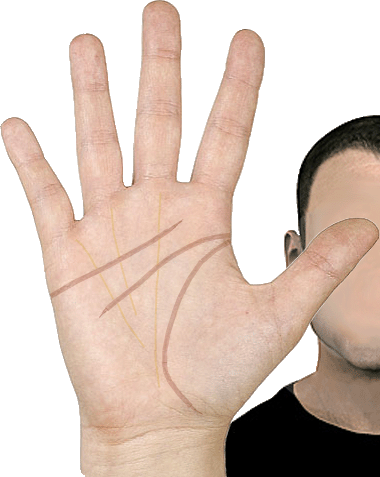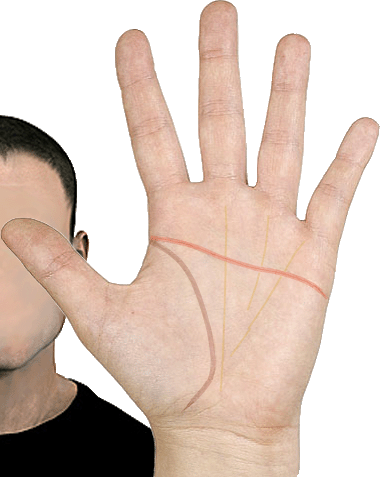SIMIAN LINE - Brief history of the simian crease!

The history of the simian line starts in 1877 when Pierre Paul Broca introduced the ethnic aspect of palmar creases in anthropology.
Since the work of Paul Brocca (1877) the simian line has been used by antropologists for studying variations among ethnic populations.
In time researchers have found that the occurence of the simian line may vary from about 1% to 2% in various European population (including the Swiss, Dutch) to above 10% in various Asian populations.
The medical significance of the simian line as a diagnostic marker started in 1906 with a report by R.L. Down, who described the relationship between the simian crease and Down's syndrome (trisomy 21).
And in the late 30's H. Cummins described that the hand in Down syndrome is not only frequently featured with a simian line but also with a typical pattern of dermatoglyphics (a word introduced by Cummins in the 20's refering to the fingerprints and palmar patterns in the skin ridges).
But it took many years before the signifance of those observations made by Down & Cummins were generally recognized in medical science, for until 1959 (when J. Lejeune discovered that the syndrome results from an extra chromosome: trisomy 21) Down's syndrome was not yet recognized as a unique disorder.
Much later, e.g. Kimura (1991) found in prenatal studies based on the hand developement in embryos that the simian line typically starts developing not before the second half of the 3rd month of pregnancy; though it might then still take a few more months before a full simian crease is formed.

Photo: simian line in hand of a third trimester fetus with Down syndrome.
But research methods improved since then, and today medical experts are even able to recognize a simian line of an unborn child with Down syndrome from an echography (see picture on the right).
Studies have indicated that the simian line is observed in 28% to 86% of people with Down syndrome (according various sources), while the simian line is seen in only about 1% of the healthy people.



NOTICE - Important ... do not forget:
While the simian line has been linked with a Down syndrome + a 'rainbow' of other syndromes, deseases & medical problems - people with a simian line can have a 'perfect' health during their full life span!
So, regarding the application of hand diagnostics on individuals with a simian line one really needs to consider other characteristics of their hands before one can make any significant observations (see the section: Down syndrome).
The genetic aspects of the simian line were first studied by Schiller (1942) and Wurth (1949), with the help of twins and family data.
Schiller studied similarity in the palm patterns of twins and learned that in identical twins the similarity was great in 74.4% of all cases studied.
In fratenal twins, on the other hand the pattern were often different and could be said to resemble each other slightly in only 28.4% of all cases studied.
Various medical sources state that the simian line is usually about twice more frequently observed in the hands of men compared to women. More specific info is provided by H. Asano from Japan (Hands, 1985) provided very interesting data on the occurence of the simian line in various Japanese populations, including:
• Children:
- five pupil populations (average of: 4.1 % in males vs. 2.4 % in females);
- breast-feeding infants (3.5 % in males vs. 3.0 % in females);
• Adult populations:
- Other criminals (5.4 % in males);
- Political criminals (5.0 % in males);
- Educators (4.7 % in males, 3.4 % in females);
- Lawyers (3.8 % in males);
- Doctors (2.2 % in males);
• Medical & psychiatric problems:
- schizophrenics (5.0-53.0 %);
- rheumatoid arthritis patients (15.91 %);
- psoriasis patients (males: 3.8-13.3 %, females: 6.0-14.2 %);
- diabetes mellitus patients (males: 3.8-13.3 %, females: 6.0-14.2 %);
- mentally retarded children (8.6 % in males vs. 8.3 % in females);
- epileptics (5.0 % in males vs. 5.4 % in females);
NOTICE: The data provided by Asano includes various interesting patterns; e.g. the data suggest that the simian line related sexe difference might actually disappear in various types of medical problems.
So, according race and region, genetics and sexe the influence of heredity of the simian line appears to be large. Asano suggests that the genetic transmission of the simian line is most susceptible of all palmar line patterns. Asano writes:
"Even if only one parent has this so-called 'masukaka' palm pattern [simian line], characterized by two instead of the normal three basic lines, it is highly likely to appear in the children's hands.
Comming to a similar conclusion after examining the hands of 62 families, the German anthropologist H. Schiller said that, when both parrents demonstrate it, the 'masukaka' patterns [simian line] occurs in the children's hand with more than triple the ordinary rate of probability."
"... In six out of ten cases, when the starting point of these lines are seperate in the palms of both parents, they will be seperate in the palms of children. In such instances, children rarely demonstrate either the pattern in which the starting points overlap or the masukake pattern [simian line]."
Finally, various studies have indicated that the simian line is usually more frequently observed in the left-hand (1.3%) - compared to the right hand (0.8%).
Next section:
• Ethnicity & the simian line!
![]() THE SIMIAN LINE BY DETAIL:
THE SIMIAN LINE BY DETAIL:
INTRO: The simian line: a minor physical anomaly!
• HOW TO RECOGNIZE Simian Lines?
• WHY THE NAME Simian Line?
• HISTORY of the Simian Line
• ETHNICITY & the Simian Line
• HEALTH & the Simian Line
• PSYCHOLOGY & BEHAVIOR: the Simian Line
• BIG FIVE PROFILING: personality & Simian Line
• PSYCHODYNAMIC PROFILES: the Simian Line
• HAND SIGN TUTOR: Simian Line - quick summary
• FAMOUS PEOPLE with Simian Lines [80+ celebs]
• PROJECTS related to the Simian Line
• ONLINE READINGS for the Simian Line
• SYNONYMS for the Simian Line


- NORMAL HAND LINES versus THE SIMIAN LINE -
![]() SIMIAN LINE & HAND DIAGNOSTICS:
SIMIAN LINE & HAND DIAGNOSTICS:
• The hand in DOWN SYNDROME!
_- Down syndrome case study 1
_- Down syndrome case study 2
• The hand in FRAGILE-X SYNDROME!
_- Fragile-X syndrome case study 1
_- Fragile-X syndrome case study 2
_(In people with autism 2% to 6% have Fragile-X syndrome!)
• The hand in DIABETES MELLITUS!
• The hand in RHEUMATOID ARTHRITIS!
• The hand in PSORIASIS!
• The hand in SCHIZOPHRENIA!
• The hand in Extraversion & Introversion
![]() HAND TESTS:
HAND TESTS:
• MARFAN SYNDROME hand test!
![]() MORE HAND DIAGNOSTICS:
MORE HAND DIAGNOSTICS:
• Hand lines (palmar creases)
• Sydney line
• Life line
• Marriage line
• Palm reading lines
• Hand Lines News
• Understanding hand shape!
• Fingerprints (+ dermatoglyphics)
• The Hypothenar whorl
• What can finger length reveal?
• The 5th finger (pinky)
• The fingernail tutor
• HAND SIGN TUTOR: Simian Line
